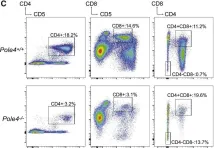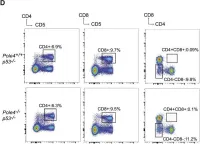We are naturally chimeras. Apart from our own cells originating from the fertilized egg, placental mammals receive small numbers of maternal cells called maternal microchimerism (MMc) that persist throughout one's whole life. Not only are varying frequencies of MMc cells reported in seemingly contradicting phenomena, including immune tolerance and possible contribution to autoimmune-like disease, but frequencies are observable even among healthy littermates showing varying MMc frequencies and cell type repertoire. These varying differences in MMc frequencies or cell types could be contributing to the diverse phenomena related to MMc. However, factors biasing these MMc differences remain largely unknown. Here, we tested whether immunological activation leads to differing MMc frequencies, based on our recent study that suggests that most maternal cells are immune-related. Unexpectedly, fluorescence-activated cell sorting analysis on the murine spleen, thymus, and liver following maternal immune activation by mid-gestational lipopolysaccharide intraperitoneal injections detected no significant difference in the number, or ratio of, immune-related maternal cells in the tested embryonic organs of healthy offspring. These findings suggest that MMc frequencies remain stable even under immune-activated conditions, implying a possible control system of MMc migration against changes in the immunological conditions.
© 2024. Published by The Company of Biologists.
Product Citations: 14
Maternal immune activation does not affect maternal microchimeric cells.
In Biology Open on 15 December 2024 by Borges, A. & Irie, N.
-
Immunology and Microbiology
In Cardiovascular Research on 16 October 2023 by Nicol, T., Falcone, S., et al.
Mitochondrial Complex I assembly (MCIA) is a multi-step process that necessitates the involvement of a variety of assembly factors and chaperones to ensure that the final active enzyme is correctly assembled. The role of the assembly factor evolutionarily conserved signalling intermediate in the toll (ECSIT) pathway was studied across various murine tissues to determine its role in this process and how this varied between tissues of varying energetic demands. We hypothesized that many of the known functions of ECSIT were unhindered by the introduction of an ENU-induced mutation, while its role in Complex I assembly was affected on a tissue-specific basis.
Here, we describe a mutation in the MCIA factor ECSIT that reveals tissue-specific requirements for ECSIT in Complex I assembly. MCIA is a multi-step process dependent on assembly factors that organize and arrange the individual subunits, allowing for their incorporation into the complete enzyme complex. We have identified an ENU-induced mutation in ECSIT (N209I) that exhibits a profound effect on Complex I component expression and assembly in heart tissue, resulting in hypertrophic cardiomyopathy in the absence of other phenotypes. The dysfunction of Complex I appears to be cardiac specific, leading to a loss of mitochondrial output as measured by Seahorse extracellular flux and various biochemical assays in heart tissue, while mitochondria from other tissues were unaffected.
These data suggest that the mechanisms underlying Complex I assembly and activity may have tissue-specific elements tailored to the specific demands of cells and tissues. Our data suggest that tissues with high-energy demands, such as the heart, may utilize assembly factors in different ways to low-energy tissues in order to improve mitochondrial output. These data have implications for the diagnosis and treatment of various disorders of mitochondrial function as well as cardiac hypertrophy with no identifiable underlying genetic cause.
© The Author(s) 2023. Published by Oxford University Press on behalf of the European Society of Cardiology.
-
Mus musculus (House mouse)
-
Cardiovascular biology
-
Cell Biology
Preprint on Research Square on 14 March 2023 by Tsai, P., Hsu, W., et al.
Phosphatase and tensin homolog (PTEN) is a negative regulator for PI3K signaling essential for B cell development. To explore the physiological effects of PTEN mutation on peripheral B cells, we generated CD23/cre-PTEN Flox/Flox (CD23-cKO) mice in this study to avoid the developmental arrest. The mutant mice develop systemic inflammation associated with B cell expansion in the early phase followed with a severe immune cell-infiltration in multiple vital organs. PTEN deficiency leads to an accumulation of PI(3)P, an increase of lysosomal recruitment of TLR9/p38 complex, and an aberrant activation of TLR9/IL-6 axis in B cells. Interestingly, cholesterol biosynthesis pathway is upregulated in mutant cells upon TLR9 engagement. A blockade of cholesterol biosynthesis by targeting SQLE greatly reduces the level of PI(3)P and the interaction between TLR9 and p38, which lowers the level of TLR9-induced IL-6. Thus, PTEN represents a critical metabolic checkpoint that fine-tunes lipid and cholesterol homeostasis to control TLR9-driven inflammation.
-
FC/FACS
-
Mus musculus (House mouse)
-
Biochemistry and Molecular biology
-
Cell Biology
-
Immunology and Microbiology
Rare t(X;14)(q28;q32) translocation reveals link between MTCP1 and chronic lymphocytic leukemia.
In Nature Communications on 3 November 2021 by Walker, J. S., Hing, Z. A., et al.
Rare, recurrent balanced translocations occur in a variety of cancers but are often not functionally interrogated. Balanced translocations with the immunoglobulin heavy chain locus (IGH; 14q32) in chronic lymphocytic leukemia (CLL) are infrequent but have led to the discovery of pathogenic genes including CCND1, BCL2, and BCL3. Following identification of a t(X;14)(q28;q32) translocation that placed the mature T cell proliferation 1 gene (MTCP1) adjacent to the immunoglobulin locus in a CLL patient, we hypothesized that this gene may have previously unrecognized importance. Indeed, here we report overexpression of human MTCP1 restricted to the B cell compartment in mice produces a clonal CD5+/CD19+ leukemia recapitulating the major characteristics of human CLL and demonstrates favorable response to therapeutic intervention with ibrutinib. We reinforce the importance of genetic interrogation of rare, recurrent balanced translocations to identify cancer driving genes via the story of MTCP1 as a contributor to CLL pathogenesis.
© 2021. The Author(s).
-
FC/FACS
-
Mus musculus (House mouse)
-
Cancer Research
In Frontiers in Immunology on 27 April 2021 by Prasad, M., Wojciech, L., et al.
Deletion of the gene for Themis affects T cell selection in the thymus, which would be expected to affect the TCR repertoire. We found an increased proportion of cells expressing Vα3.2 (TRAV9N-3) in the peripheral CD8+ T cell population in mice with germline Themis deficiency. Analysis of the TCRα repertoire indicated it was generally reduced in diversity in the absence of Themis, whereas the diversity of sequences using the TRAV9N-3 V-region element was increased. In wild type mice, Vα3.2+ cells showed higher CD5, CD6 and CD44 expression than non-Vα3-expressing cells, and this was more marked in cells from Themis-deficient mice. This suggested a virtual memory phenotype, as well as a stronger response to self-pMHC. The Vα3.2+ cells responded more strongly to IL-15, as well as showing bystander effector capability in a Listeria infection. Thus, the unusually large population of Vα3.2+ CD8+ T cells found in the periphery of Themis-deficient mice reflects not only altered thymic selection, but also allowed identification of a subset of bystander-competent cells that are also present in wild-type mice.
Copyright © 2021 Prasad, Wojciech, Brzostek, Hu, Chua, Tung, Yap, Rybakin and Gascoigne.
-
Mus musculus (House mouse)
-
Immunology and Microbiology
In Mol Cell on 17 May 2018 by Bellelli, R., Borel, V., et al.
Fig.2.C

-
FC/FACS
-
Mus musculus (House mouse)
Collected and cropped from Mol Cell by CiteAb, provided under a CC-BY license
Image 1 of 2
In Mol Cell on 17 May 2018 by Bellelli, R., Borel, V., et al.
Fig.6.D

-
FC/FACS
-
Mus musculus (House mouse)
Collected and cropped from Mol Cell by CiteAb, provided under a CC-BY license
Image 1 of 2

